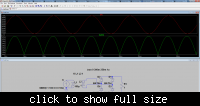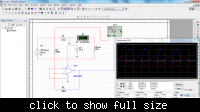Sajjadkhan
Full Member level 5
- Joined
- Sep 25, 2010
- Messages
- 307
- Helped
- 17
- Reputation
- 34
- Reaction score
- 16
- Trophy points
- 1,298
- Location
- Rawalpindi,Pakistan
- Activity points
- 4,199
Follow along with the video below to see how to install our site as a web app on your home screen.
Note: This feature may not be available in some browsers.
Something like that can work, but it works as a voltage transformer so the diodes cause nonlinearity on the output. Using a standard current transformer doesn't have this problem. Also easier to construct than what you posted (effectively no primary winding).
The non-linearity comes from the forward bias voltage of the diodes. They wont conduct until youve exceeded the forward bias this will effect readings when you are measuring small currents. There are plenty of application notes on how to use an op amp as a fullwave rectifier that does away with this limitation
In measurement technique, its called a systematic error. As it also depends on temperature and current waveform, it can't be easily cancelled in software.In simple terms that is called offset. and if current is very small and constant then that offset mearly chnages and it can be handled in software.
In simple terms that is called offset. and if current is very small and constant then that offset mearly chnages and it can be handled in software.

No, it's not just an offset, the diodes will not allow any signal to come out which is not high enough to forward bias them. Any signal content between -1.2V and +1.2V simply won't show up on the output, and that information is lost and can't be recovered.
Do you need to actually rectify the output signal? It can be done with a current transformer without introducing significant distortion, but generally the current transformer will need to have very high inductance, especially if it needs to operate at low frequencies.

No, because in my case the output of the transformer is a more like a current source than a voltage source, and the burden resistor is on the output of the rectifier, so it doesn't distort the output voltage. You can see the waveforms give a good linear measurement (1A of current through a 1:100 CT, with a 1 ohm burden resistor gives 10mV output).yes you are right, that info cant be recovered. In that case dont you think the rectifier you and i used also contributes to the error? i think so.
The CT + rectifier circuit has a residual nonlinearity caused by the transformer main inductance, but surely lower than the primary shunt variant.
Correct, it will have some finite amount of distortion, especially at low signal amplitudes. For lower distortion, the CT can be connected directly to the burden resistor, and then a precision active rectifier can be used. Best of all would probably be a transimpedance amplifier instead of a burden resistor.The CT + rectifier circuit has a residual nonlinearity caused by the transformer main inductance, but surely lower than the primary shunt variant.

